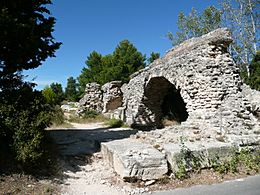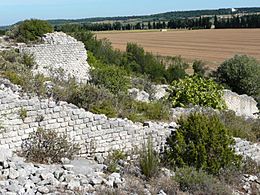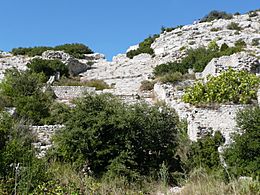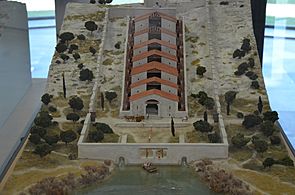Barbegal aqueduct and mills facts for kids

The aqueduct
|
|
| Location | Fontvieille, Bouches-du-Rhône, France |
|---|---|
| Coordinates | 43°42′09″N 4°43′17″E / 43.70250°N 4.72139°E |
The Barbegal aqueduct and mills is a Roman watermill complex located on the territory of the commune of Fontvieille, Bouches-du-Rhône, near the town of Arles, in southern France. The complex has been referred to as "the greatest known concentration of mechanical power in the ancient world" and the 16 overshot wheels are considered the biggest ancient mill complex.
Another similar mill complex existed on the Janiculum in Rome, and there are suggestions that further such complexes existed at other major Roman sites, such as Amida (Mesopotamia).
Description
The Barbegal mills are located 12 kilometers east northeast of Arles near Fontvieille, where the Arles aqueduct arrived at a steep hill. The mills consisted of 16 water wheels in two parallel sets of eight descending a steep hillside. There are substantial masonry remains of the water channels and foundations of the individual mills, together with a staircase rising up the hill upon which the mills were built. The mills operated from the beginning of the 2nd century until about the end of the 3rd century. The capacity of the mills has been estimated at 4.5 tons of flour per day, enough to supply bread for as many as 10,000 of perhaps 30–40,000 inhabitants of Arelate at that time. It is thought that the wheels were overshot water wheels with the outflows driving successive wheels to the base of the hill.
The Roman aqueducts that fed the mills were also built to supply water to the town of Arles (then called Arelate). The two aqueducts joined just north of the mill complex and a sluice controlled the water supply to the complex.
Other mills
Vertical water mills were well known to the Romans, being described by Vitruvius in his De architectura of 25 BC, and mentioned by Pliny the Elder in his Naturalis Historiæ of 77 AD. There are also later references to floating water mills from Byzantium and to sawmills on the river Moselle by the poet Ausonius. The use of multiple stacked sequences of reverse overshot water wheels was widespread in Roman mines, especially in Spain and Wales. It is possible that the mills at Barbegal may also have been used for sawing timber and stone when not grinding wheat. The Hierapolis sawmill from the 3rd century AD shows a crank-activated frame saw being used in this way, and another has been excavated at Ephesus.
Visiting the site
Visitors to Barbegal may park where a minor road (Route de L’Aqueduc) crosses the massive remains of the original aqueduct, and, with olive orchards on either side, walk south about 250 meters along the remains of the aqueduct and through the three meter deep rock-hewn cleft emerging at the top of the mill complex. The site is signposted as "Roman aqueduct" rather than as a mill. The Arles Museum of Antiquity has an informative reconstructed model of the mill. The site is currently overgrown, and care is needed exploring the ruins.
Influence
The English science historian James Burke examines Roman watermill technology such as that of the Barbegal aqueduct and mill, concluding that it influenced the Cistercians and their waterpower, which in turn influenced the Industrial Revolution, in the fourth of his ten-part Connections, called "Faith in Numbers".
See also
 In Spanish: Acueducto y molinos de Barbegal para niños
In Spanish: Acueducto y molinos de Barbegal para niños






